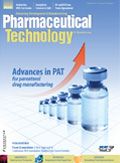Sterilizing with Nitrogen Dioxide
Room-temperature sterilization using nitrogen dioxide gas benefits parenteral drugs.
Nitrogen dioxide (NO2) gas can provide manufacturers of parenteral drug products with a truly room- temperature means of sterilizing the external surfaces of single-dose drug containers that are intended for use in a sterile field. Other sterilization options, such as ethylene oxide (EO), hydrogen peroxide (H2O2), and radiation, may expose the drug products to elevated temperatures over extended times or penetrate the container and closure systems. Both of these scenarios can adversely affect drug products or biologics, especially those that have limited stability at elevated temperatures. NO2 is compatible with many of the materials that are common to parenteral drug containers and closure systems including glass, cyclic olefin copolymers (COC), polypropylene, silicone rubber, thermoplastic elastomers, and pharmaceutical rubbers. As a surface sterilant, NO2 does not penetrate containers or closure systems during the sterilization process, leaving the drug product unaffected.

Sterilized packages may be handled immediately after the cycle (Noxilizer, RTS 360 Industrial Nitrogen Dioxide Sterilizer). (IMAGE COURTESY OF THE AUTHOR.)
NO2 possesses some specific chemical and physical properties that make it well positioned for use as a sterilant for pressure- and temperature-sensitive parenteral drug products. Because it boils at 21°C, the NO2 sterilant can be introduced into the chamber with minimal to no vacuum. Sterilization is typically carried out using NO2concentrations that are in the range of 1–2% of the saturated vapor pressure. Because of this, condensation of the sterilant is not likely to occur, even in complicated geometries. Heating of the NO2 sterilization chamber is not required to maintain the sterilant gas phase, which allows sterilization and aeration to be carried out at room temperature. Both EO and H2O2 sterilization, however, generally require some degree of heating, which can result in destabilization of sensitive products.
NO2 sterilization provides rapid and effective inactivation of both vegetative and spore forms of bacteria. This rapid lethality allows a sterility assurance level of 10-6 to be achieved in a cycle with a typical door-to-door time of 60–120 minutes, thereby minimizing the time that the drug product is exposed to room temperature. There is no preconditioning phase, and aeration of residual sterilant from the product is included in the overall cycle time.
NO2 is compatible with many of the sterile barrier packaging options on the market, such as Tyvek pouches and plastic trays with Tyvek lids. As NO2 is a surface sterilant, the gas requires access to the product, which is afforded by the breathable Tyvek. Sterilization with NO2 would typically be carried out in the primary packaging, and any instructions for use would be included in the secondary package.
NO2 sterilant, while a toxic gas, is non-carcinogenic and non-flammable, which makes it attractive as an option to bring sterilization onto the manufacturing floor for higher volume manufacturers. In-house sterilization offers potential savings in terms of both transportation and inventory carrying costs associated with contract sterilization. Sterilization can be placed in-line between primary and final packaging operations. For manufacturers whose volumes are not large enough to warrant on-site sterilization, yet who require room-temperature sterilization, contract NO2 sterilization is an option.
Evan Goulet, PhD, is technical applications manager at Noxilizer, Baltimore, MD, info@noxilizer.com.

Drug Solutions Podcast: A Closer Look at mRNA in Oncology and Vaccines
April 30th 2024In this episode fo the Drug Solutions Podcast, etherna’s vice-president of Technology and Innovation, Stefaan De Koker, discusses the merits and challenges of using mRNA as the foundation for therapeutics in oncology as well as for vaccines.
Pharmaceutical Tariffs Are Imminent: How Industry is Bracing for Impact
April 16th 2025On April 14, 2025, the Trump Administration launched a national security-driven investigation into pharmaceuticals, a move that will likely result in tariffs being placed on pharmaceutical drugs, ingredients, and other components that are imported from outside of the United States.